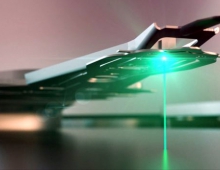
Backblaze's Q1 2018 HDD Reliability Stats for Q1 2018
Backblaze has released its latest hard drive reliability report, based on the company's enormous storage pool, and the results this quarter seems to be better than previously.
As of March 31, 2018, Backblaze had 100,110 spinning hard drives. Of that number, there were 1,922 boot drives and 98,188 data drives. Backblaze's review looks at the quarterly and lifetime statistics for the data drive models in operation in the company's data centers.
For the evaluation below the company removed from consideration those drives which were used for testing purposes and those drive models for which the company did not have at least 45 drives. This leaves the report with 98,046 hard drives. The table below covers just Q1 2018.
If a drive model has a failure rate of 0%, it only means there were no drive failures of that model during Q1 2018.

As you can see, the overall Annualized Failure Rate (AFR) for Q1 was just 1.2%, well below the Q4 2017 AFR of 1.65%.
Below is the lifetime failure rate chart for all the hard drive models which have 45 or more drives in operation as of March 31st, 2018. For each model, Backblaze computes their reliability starting from when they were first installed.

The failure rates of all of the larger drives (8-, 10- and 12 TB) are very good, 1.2% AFR (Annualized Failure Rate) or less. Many of these drives were deployed in the last year, so there is some volatility in the data, but you can use the Confidence Interval to get a sense of the failure percentage range.
The overall failure rate of 1.84% is the lowest Backblaze has ever achieved, besting the previous low of 2.00% from the end of 2017.
Helium makes a difference in drive failure rates?
In November 2013, the first commercially available helium-filled hard drive was introduced by HGST, a Western Digital subsidiary. The 6 TB drive was not only unique in being helium-filled, it was for the moment, the highest capacity hard drive available. Fast forward a little over 4 years later and 12 TB helium-filled drives are readily available, 14 TB drives can be found, and 16 TB helium-filled drives are arriving soon.
Backblaze has been purchasing and deploying helium-filled hard drives over the past year and has started looking at their failure rates compared to traditional air-filled drives.
Inside of an air-filled hard drive there are rapidly spinning disk platters that rotate at a given speed, 7200 rpm for example. The air inside adds an appreciable amount of drag on the platters that in turn requires an appreciable amount of additional energy to spin the platters. Replacing the air inside of a hard drive with helium reduces the amount of drag, thereby reducing the amount of energy needed to spin the platters, typically by 20%.
As you know, a helium-filled balloon sinks to the ground after a few days. This was one of the key challenges in using helium inside of a hard drive: helium escapes from most containers, even if they are well sealed. It took years for hard drive manufacturers to create containers that could contain helium while still functioning as a hard drive. This container innovation allows helium-filled drives to function at spec over the course of their lifetime.
"SMART 22" is the attribute assigned to recording the status of helium inside of a hard drive. This attribute is found in the SMART Attributes reported by an HGST hellium hard drive. It actually denotes the status of the Helium in a drive. It is a pre-fail attribute that trips once the drive detects that the internal environment is out of specification.
Although Backblaze has both HGST and Seagate helium-filled hard drives, only the HGST drives currently report the SMART 22 attribute. It appears the normalized and raw values for SMART 22 currently report the same value, which starts at 100 and goes down.

According to Backblaze, to date only one HGST drive has reported a value of less than 100, with multiple readings between 94 and 99. That drive continues to perform fine, with no other errors or any correlating changes in temperature, it is not yest clear whether the change in the SMART 22 value is trying to tell something or if it is just a wonky sensor.
Backblaze decided to use just 8, 10, and 12 TB helium-filled drives in the comparison.
The most obvious observation is that there seems to be little difference in the Annualized Failure Rate (AFR) based on whether they contain helium or air. One conclusion, given this evidence, is that helium doesn't affect the AFR of hard drives versus air-filled drives.
Backblaze assumes that after normalizing the data so that the helium and air-filled drives have the same (or similar) usage (Drive Days), the helium-filled drives we use will continue to have a lower Annualized Failure Rate versus the air-filled drives.





















